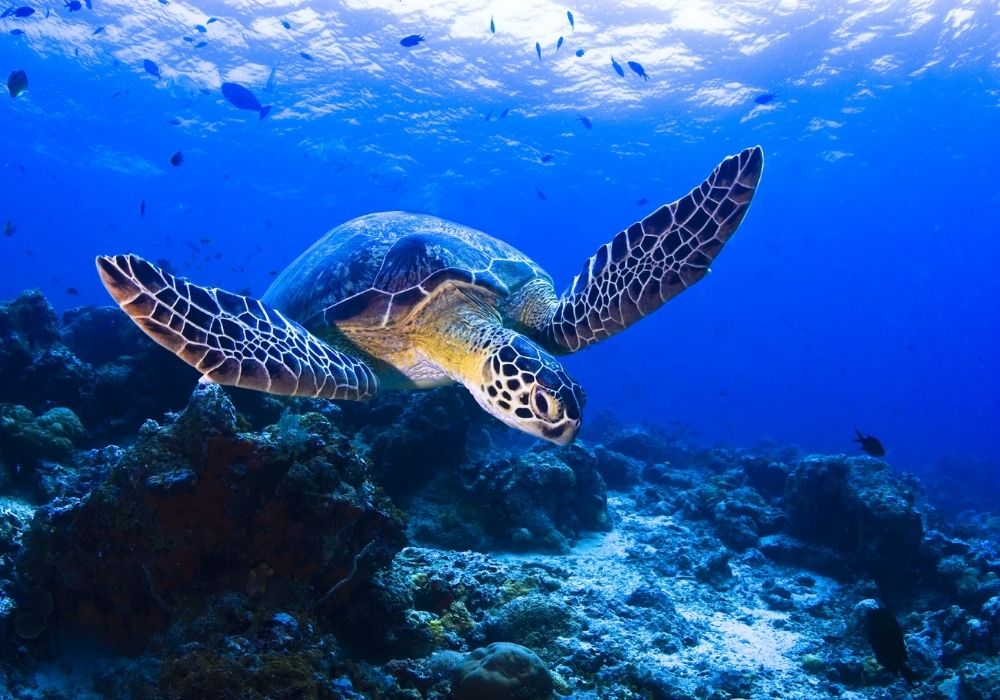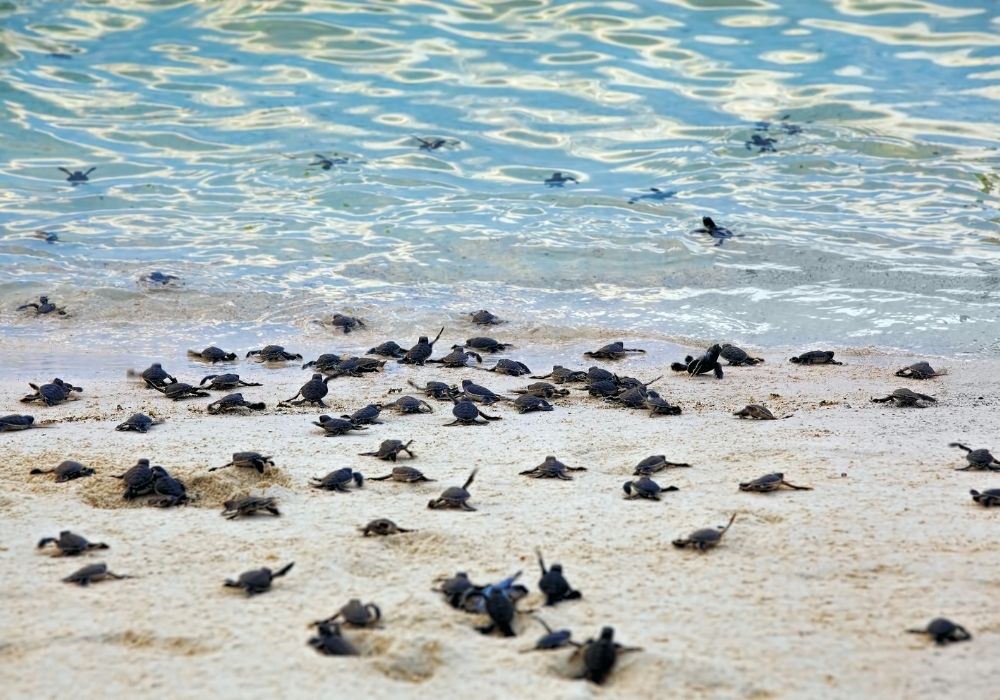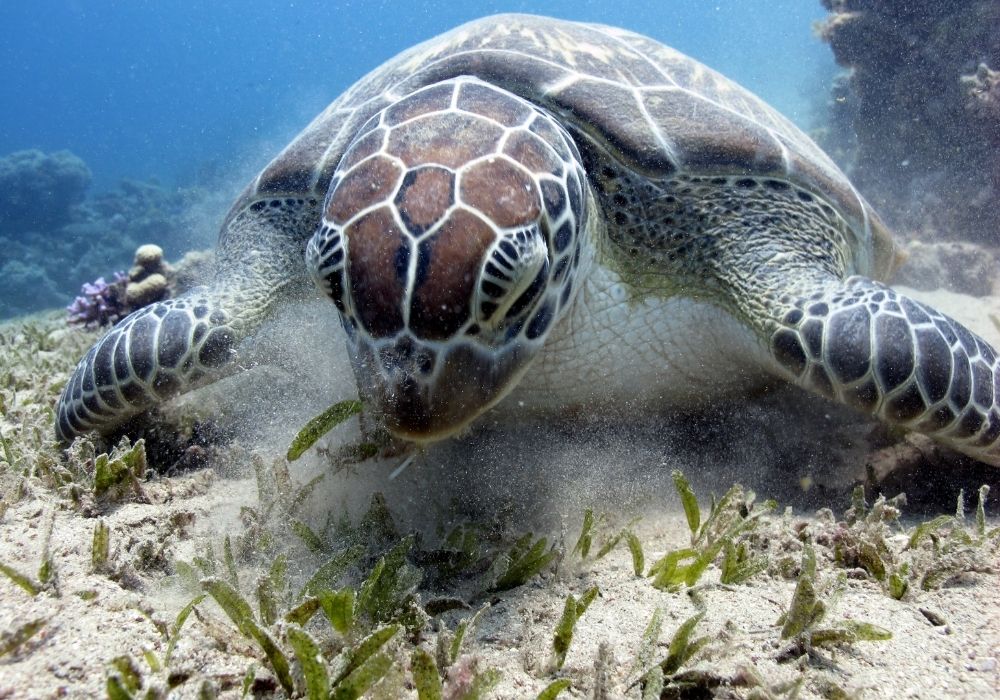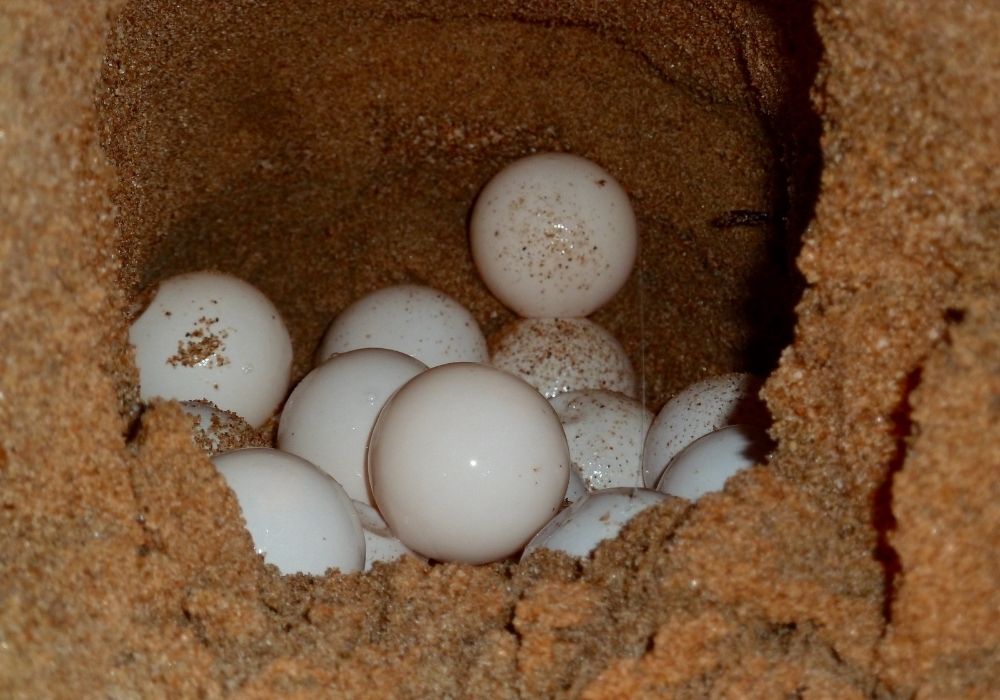Sea turtles are extremely old. They have been on our planet for 100 million years. Sea turtles have been around so long that they saw the dinosaurs come and go.
But now, our amazing sea turtles are endangered. There are many reasons for sea turtles becoming endangered in the last 200 years. And, sadly, as with many species that are on the brink of extinction, their endangered status is due to human activity.
In fact, humans are responsible for 99% of species extinction globally.
Once there were millions of sea turtles on Earth, but now the number has dwindled considerably. Conservation efforts are being made around the world but there is much more that needs to be done.
It’s important that we learn about this remarkable animal and do as much as we can to protect the sea turtle.
About sea turtles – an overview
Sea turtles are reptiles with a shell and (for the majority of species) scales. They breathe oxygen. The scientific names of the two families of sea turtle are Cheloniidae and Dermochelyidae.
Turtles have a type of beak rather than teeth. They have eardrums which are under the skin and can hear low frequency sounds well.
Sea turtles come onto the land to lay eggs but they spend most of their lives in the ocean. Some species live in the open water and some species stay closer to the shore.
Males do not usually come back to the shore after they have hatched and go into the ocean. Females return to the shore to nest.
In the water, their vision is excellent, but they cannot see as well when they’re on the land. This does vary somewhat for different species. It is unknown whether sea turtles have colour vision.
They have a good sense of smell which they use both to find food and avoid predators.
Turtle shells
Turtle shells come in two parts – the top, called a carapace, and the bottom, called a plastron. These two pieces create a hard box-like structure around the body of the sea turtle by joining on each side. Turtle shells are made of bone and cartilage.
The shells are part of their bodies and attached to them, so they cannot shed it or exit it like other animals that have shells.
The shells of sea turtles tend to be high and dome-shaped, except the flatback turtle described below.
Where do sea turtles live?
Sea turtles live in the tropical parts of oceans all over the world. They come onto the shores to nest, and often travel thousands of miles to mate and to nest. The majority of them live in the seas around South Asia and around the south-eastern part of North America.
In Europe, they can be spotted in locations such as Greece and Portugal.
The specific location of the sea turtles varies depending on the species.
What do sea turtles eat?
Different species of turtle have different diets. Some are carnivores, some herbivores and some omnivores. Some species alter their diets as they grow older.
None of them have any teeth!
Here is some more detailed information on the different species of sea turtles.
Different species of sea turtles
There are seven species of turtle, all of which are endangered or threatened. The different species vary significantly in size. Some are the size of dinner plates, and leatherheads can reach the size of golf carts! They can be differentiated by their appearance as well as some of their behaviours.
Green sea turtle
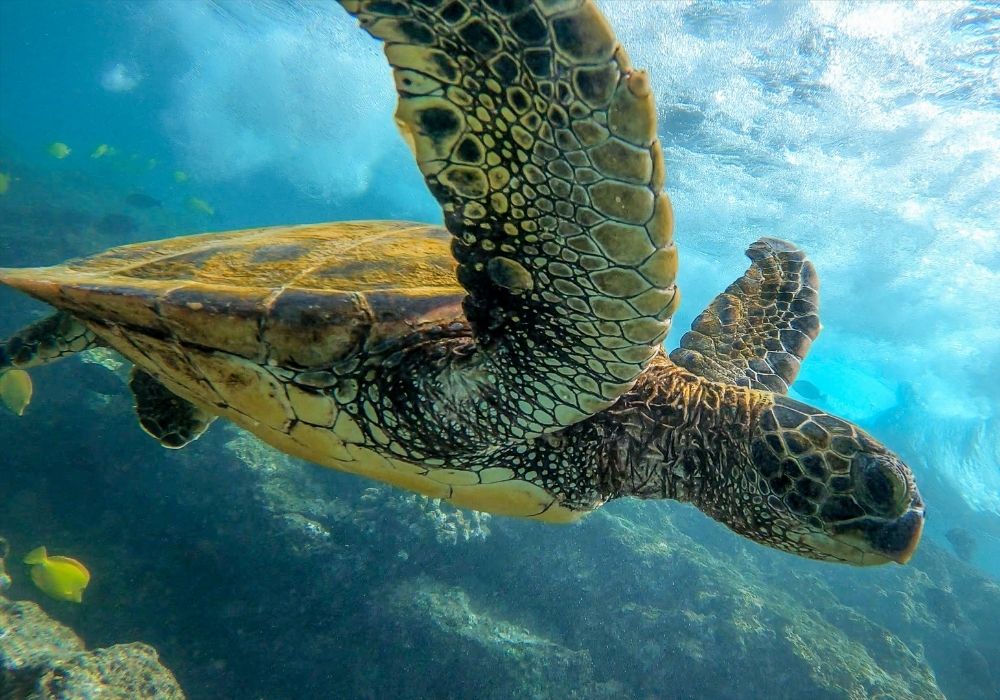
Appearance:
The green turtle can be distinguished from other turtles by its small, blunt head and its single pair of scales over its eyes, rather than the two pairs that other species of turtles have.
The carapace (top part of the shell) can be plain dark green or bright yellow, brown and green with stripes. The plastron (underside of the shell) can be pale yellow or white in green sea turtles in the Atlantic, or darker grey, blue or green in green sea turtles in the Pacific.
Size:
The green turtle is the largest species of marine turtle.
Lifespan:
It is somewhat difficult to judge the exact lifespans of turtles in the wild, as they can be difficult to track, and their lifespan differs in captivity.
The lifespan of the green turtle is thought to be at least 60 years old.
Habitat and nesting:
Green turtles can be found all over the world, along the coast of over 140 countries. They nest in more than 80 different countries.
The largest populations of green turtles are on Raine Island on the Great Barrier Reef, with an average of 18,000 females nesting each season, and Tortuguero on the Caribbean coast in Costa Rica, with an average of 22,500 females nesting each season.
Green sea turtles tend to stay near the coastline rather than venturing into the open water.
Diet:
Unlike the other six species of sea turtle, green turtles are herbivores. Although, interestingly, when they are young, they eat worms, insects and crustaceans as well as algae and seagrasses.
Loggerhead sea turtle
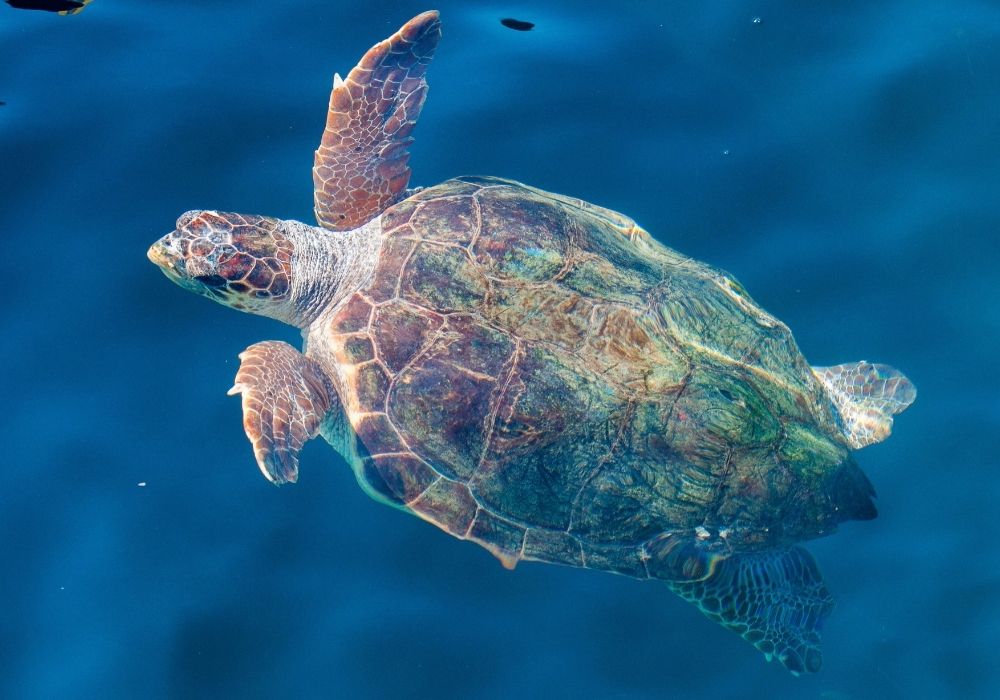
Appearance:
The loggerhead turtle has a large head and powerful jaw. They have a heart-shaped carapace which is reddish brown. The plastron of the loggerhead is pale yellow. Their flippers and neck are yellow and brown.
Size:
Loggerheads weigh up to 113 kilos and are 90-100cm in length.
Lifespan:
Loggerhead turtles are thought to live to be around 70-80 years old.
Habitat and nesting:
The loggerhead turtle is most commonly spotted of all the turtles in the US. They have their largest nesting sites in Oman and in Florida. These are the only sites with over 10,000 females.
The loggerhead is also the only sea turtle which nests outside of tropical areas.
Narrow, sloped and coarse beaches are the loggerheads’ preferred location for nesting. Hatchlings swim away from the shore for several days and spend time growing and feeding in areas with dense algae and seagrasses. Sadly, they often ingest plastic in these areas of vegetation as it collects here.
For approximately 12 years, loggerheads live in the ocean water then move towards the coast. These areas around the coast provide a habitat for young loggerheads to forage, migrate, and live between nesting periods.
Diet:
Loggerheads are mostly carnivores and rarely eat vegetation, which is why they have such powerful jaws. They eat small animals including invertebrates that live in the algae and seaweed.
Kemp’s ridley sea turtle
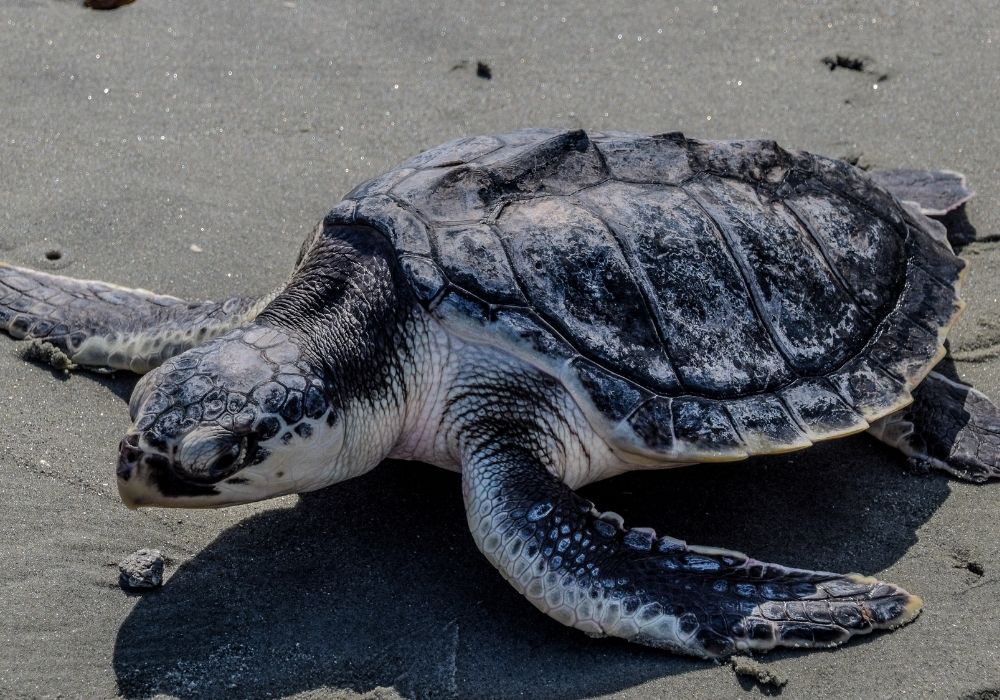
Appearance:
The Kemp’s ridley turtle has a somewhat hooked beak and its head is triangular. Hatchlings are darker in colour and adults develop a pale yellow plastron and a grey-green carapace, which is as wide as it is long.
Its back flippers have one or two claws and its front flippers have one claw each.
Size:
The Kemp’s ridley sea turtle and the Olive ridley are the smallest of the sea turtles. The Kemp’s ridley weighs approximately 45 kilos and is 60-70cm in length.
Lifespan:
Kemp’s ridley turtles are thought to live at least 30 years.
Habitat and nesting:
The Kemp’s ridley sea turtle is mainly found in the Gulf of Mexico as well as the Atlantic. Its nesting practice is called “arribada”. This is where large groups of females all nest at the same time in the same location, which may be because of environmental causes or to protect themselves.
The Kemp’s ridley turtle is the only sea turtle that usually nests during the day.
Diet:
Younger Kemp’s ridley turtles eat smaller animals and plants in the algae when they are in the depths of the Gulf of Mexico. When they grow older and move to the coast, they eat crabs.
Olive ridley sea turtle
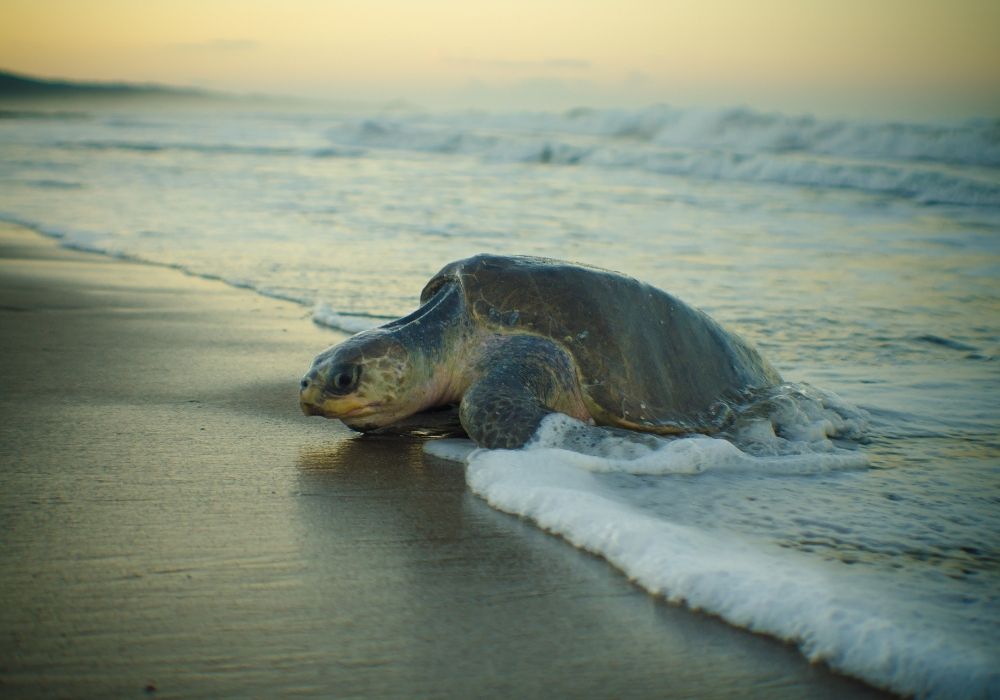
Appearance: The Olive ridley turtle has an olive-green carapace, hence the name. They look very similar to the Kemp’s ridley turtle.
Size: The Olive ridley, along with the Kemp’s ridley, is the smallest of the sea turtles. It is 40 kg, 55-80 cm.
Lifespan: It is not known exactly how long the Olive ridley lives but it is thought to be between 10 and 50 years.
Habitat and nesting:
The Olive ridley is found in the tropics in the Indian, Atlantic, and Pacific Oceans.
This species of turtle also engages in “arribada” nesting, where all the females nest at once.
The Olive ridley is the most abundant of all sea turtles, however, according to the International Union for Conservation of Nature and Natural Resources Red List, their numbers have dropped between 30 and 50 per cent.
Diet:
The Olive ridley is an omnivore and eats everything from algae to lobsters, fish, crabs, shrimps and molluscs. These turtles dive 150 metres to feed on bottom feeding animals.
Hawksbill sea turtle
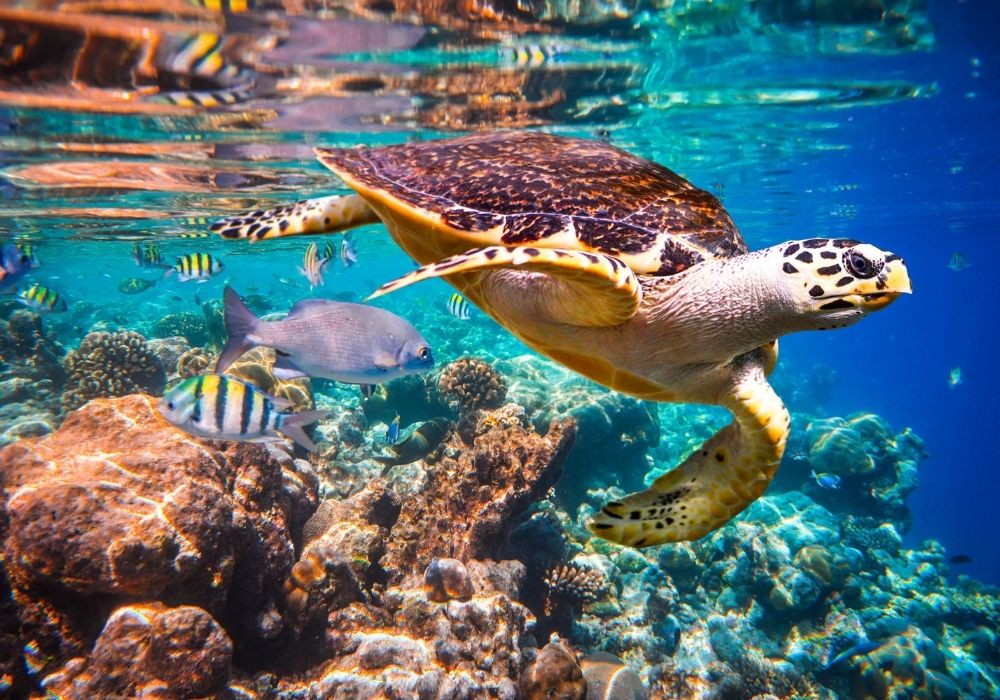
Appearance:
Hawksbill turtles can be differentiated because they have a pointy head and a mouth that looks like a beak, hence its name.
Their shells are amber in colour and patterned. Their plastron is yellow and they have serrated, bony shells with orange, black and red streaks. They have two claws on each flipper, which is different to other species.
Size:
Hawksbill turtles are small to medium-sized turtles. They weigh between 45-70 kg and are generally 65-90 cm in length.
Lifespan:
Hawksbill turtles live approximately 30 to 50 years.
Habitat and nesting:
These turtles live in the tropical waters of the Atlantic, Pacific and Indian Oceans. They nest in remote areas and not in large numbers, so it is difficult to get accurate information about how many of these turtles there are.
Some migrate long distances to nest, but others do not travel far. This species of turtle lives in and around coral reefs.
Diet:
Hawksbill sea turtles primarily live on sponges that can be found in coral reefs. Although they also eat other species such as jellyfish, algae, crustaceans, and so on. The destruction of coral habitats is the main reason that these turtles are endangered.
Before plastic was used in glasses, the shell of the hawksbill used to be used as a material for glasses frames, and this has also led to its endangered status.
Flatback sea turtle
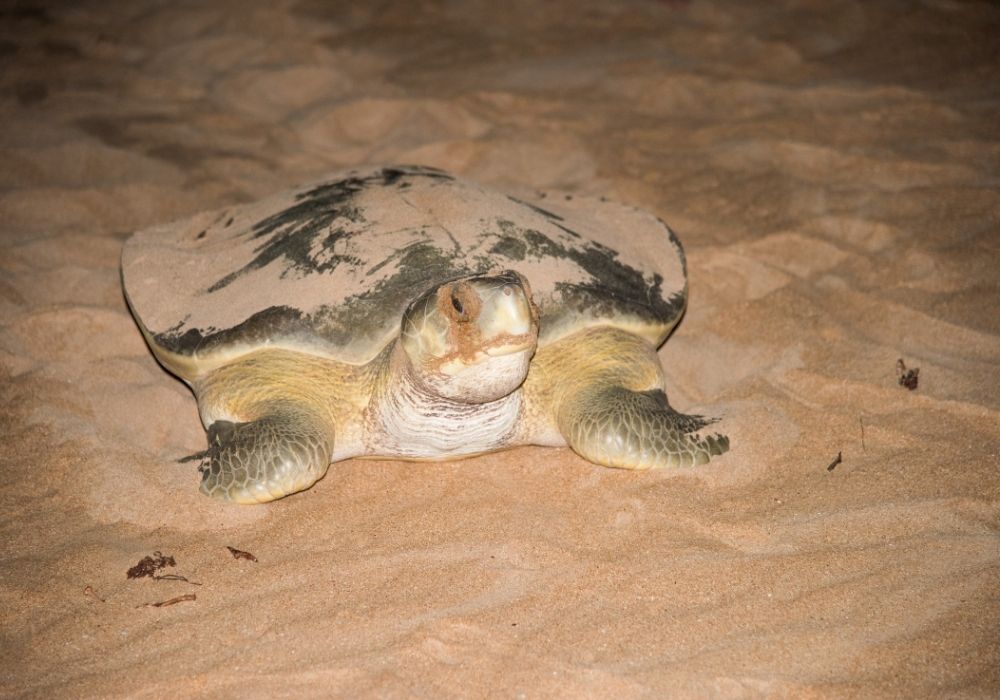
Appearance:
Unsurprisingly from the name, this species of turtle is very flat in appearance. It is olive green or grey on the carapace and has a cream-coloured plastron. The carapace of the flatback is extremely thin in comparison to other sea turtles and it is at more risk of injury to its shell.
Size:
The flatback is 76-96 cm in length and 70-90 kg in weight. The females are larger but the males have longer tails.
Lifespan:
Flatback sea turtles live up to 100 years.
Habitat and nesting:
The flatback sea turtle lives off the coast of Australia. They occasionally travel to Papua New Guinea. They live in shallow areas but not in coral reefs.
Because it lives in a small area it is not as threatened as other species of sea turtles. It is also not a desirable meat for humans.
November and December are the months that flatback turtles mate and nest. They tend to have fewer eggs than other turtles – around 50 instead of the usual 100-150.
Diet:
Flatback turtles are carnivores and feed on jellyfish, prawns, molluscs, sea cucumbers and other species that live in the shallow coastal waters that they inhabit.
Leatherback sea turtle
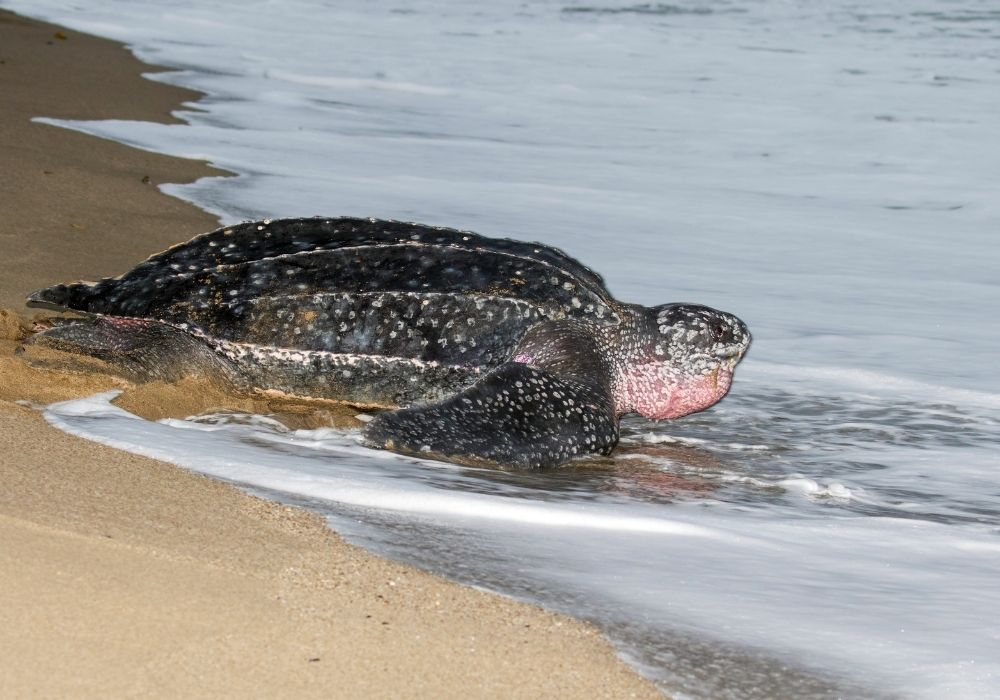
Appearance:
The leatherback turtle is the only turtle worldwide that does not have a hard shell or scales. They actually come from a different family to the other six species and have not changed or evolved since the age of the dinosaurs.
Size:
The leatherback turtle is the largest turtle in the world – it is an enormous 1.8 to 2.2 metres long and 250 to 700 kg in weight.
Lifespan:
Leatherback sea turtles live approximately 9 to 29 years old. They grow more quickly than turtles with hard shells and so reach sexual maturity more rapidly.
Habitat and nesting:
Leatherbacks used to live in every ocean in the world except the Arctic and Antarctic but they have been dying out in many locations. In the last three generations, it is thought that there has been a 40% decrease in the population.
They migrate long distances – up to a whopping 10,000 miles! They can also dive deeper than other turtles and most marine animals – around 1,200 metres.
Diet:
They eat soft and gelatinous prey, such as jellyfish, due to the differences in their mouths with other turtles.
Do sea turtles have any predators?
Baby sea turtles are under significant threat from predators, whereas adult sea turtles have few predators. Sharks such as tiger sharks and killer whales are the main predators of adult sea turtles.
Over 90% of turtle hatchlings are eaten by predators. These include crabs, dogs, fish, racoons and birds.
Sadly, the most major threat to the survival of sea turtles is not a predator, but us.
Life cycle of the sea turtle
The hatchlings that get into the open sea are somewhat of a mystery to scientists. We do not know how long they are in the open ocean. There is a hypothesis that they spend their early years floating in beds of grasses, eating and growing.
When they get larger, they can be seen feeding near the shore. It is believed that some sea turtles can live over a century, but as we’ve discussed, they are difficult to track.
The importance of sea turtles to marine ecosystems
Sea turtle decline actually began centuries ago, so scientists are unsure of the exact role that they have historically placed in the ecosystem.
What is known is that sea turtles help to keep seagrass levels healthy, as well as coral reefs. This helps balance the rest of the ecosystem by protecting marine animals and plants and their food chains, as well as the recycling of nutrients.
Green sea turtles graze on the seagrasses, which helps the seagrass blades to be more productive. It also increases the level of nutrients in these grasses. If there is no grazing, it blocks the currents due to be overgrown, and leads to mould and slime growth.
Sea turtles dislodge the older pieces of seagrass and these pieces then do not accumulate on the bottom. A build up lowers the amount of nitrogen that the plants get and has an impact on all of the animals that live in the seagrasses.
Such animals that are affected if the sea turtles do not graze on grasses include fish that live in the reef. This in turn can have a negative impact on coral reefs and lead to coral reef bleaching.
Leatherback turtles, as well as loggerhead and green turtles, make sure that jellyfish populations are controlled, as they are a major predator of the jellyfish. Without these species of turtles, fish populations will decline as jellyfish prey on fish eggs.
Sea turtles also keep fish populations up by providing nutrients for fish in the form of barnacles and other small creatures that live on their shells.
It is not only the ecosystems in the water that are impacted by turtle population decline. Beach ecosystems rely on sea turtles for diversity. Compounds in turtle eggs add more nutrients to the dunes which encourages plant growth and therefore more animals in the vegetation.
Why are sea turtles endangered?
As we’ve mentioned, sea turtles are endangered due to human activity. But there are lots of specific causes of the decline in the turtle population, making it a complicated issue to solve.
Beach development
The development of beaches into commercial tourist areas is a significant threat to the nesting environment of sea turtles. Some of this is because their sites get destroyed by property owners building walls and other structures to prevent erosion.
Beach nourishment also occurs in an attempt to stop erosion. This is where additional sand is added but this often dislodges the nesting sites of turtles or even bury nests.
Another issue with beach development is because of the artificial light created by humans inhabiting the beaches. Turtles need quiet, dark beaches to nest. They then choose a poorer spot and are less likely to be successful in their reproduction.
This same lighting can disorientate the hatchlings, leading them to crawl away from the ocean instead of towards it. often they then die of dehydration or get hit my traffic.
Fishing
Fishing is one of the most major threats to our sea turtles. There is 2.5 times more fishing taking place than can be sustained by our oceans.
By-catch is problematic for sea turtles – where they are caught by accident in nets, hooks and lines that are meant to catch fish for eating. They are then often dumped, injured, and cannot survive.
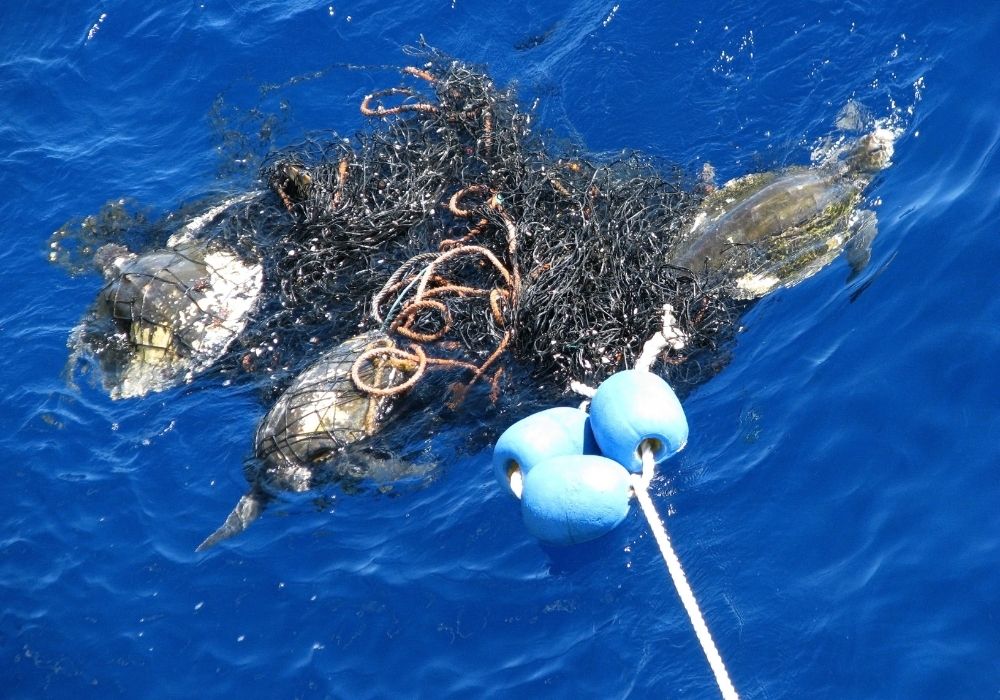
They can also get tangled in lines and nets and drown because they can’t surface for air.
Sea turtles can also ingest parts of fishing equipment (as well as other plastics) so they can’t eat properly and starve. They can also swallow hooks which can damage their organs.
Fisheries off the coast of Ecuador, Peru and Chile were estimated to kill 16,000 turtles each year, although this may be considerably higher. 250,000 each year are thought to be captured, injured or killed by fishermen in the United States. That is in two regions of the world alone.
Fishing is clearly a major contributor to the endangered and threatened status of our sea turtles.
Marine debris
More than a million animals, including sea turtles, are killed in the sea every year because of marine debris. This marine debris is primarily plastic, and it is a colossal problem for our oceans and our marine ecosystems.
It is thought that there is over a million tons of plastic in the oceans. This threatens our sea turtles by getting into their stomachs and filling them so that they can’t eat. Turtles physically cannot regurgitate this plastic, so they starve.
They also, similarly to with fishing gear, get caught in it and can’t swim. So they drown.
Plastic also threatens other marine species that turtles eat, so there is less food available for them.
And, plastic debris increases the risk of disease for turtles because pieces of plastic are the perfect mode of transport for pathogens to travel thousands of miles across the oceans. These pathogens cause sea turtles to get sick and often die.
Debris is not only a problem in water, it is also a problem on land. This is because it collects on beaches where turtles nest, and hatchlings get caught in it. They then never make it to the ocean.
Climate change
Climate change causes the sea levels to rise. Rising sea levels leads to beach erosion, and the destruction of the nesting habitats of sea turtles. Turtle nests can also be flooded by higher sea levels.
Turtles use a memory map of the oceans and beaches, and a changing climate destroys beaches. This means that the turtles cannot find their nesting sites, and they are at much more risk of being unable to reproduce.
Some turtles depend on coral reefs for survival, and rising temperatures are severely threatening the world’s coral reefs. When the coral reefs die, as does the marine life that is dependent on it for survival. Much of this marine life, such as algae and crustaceans, are eaten by sea turtles.
There is also some evidence that sea turtles, among other creatures, find it more difficult to swim in warmer water as it is more energy intensive.
As well as in the water, rising temperatures on the beaches are also highly problematic. Frequent exposure to temperatures over 34C can kill incubating sea turtles.
The temperature of the sand where sea turtle eggs are incubated impacts whether the turtle is male or female. Higher temperatures may lead to more females being born, which has a knock-on effect for the next generation, affecting the diversity of the turtle population.
In Costa Rica, there are some beaches where each year there are now 70-90% female turtles hatching. Some scientists believe that the dinosaurs went extinct due to rapid climate change and an excess of females hatching as a result.
Poaching
Turtles and turtle eggs have been eaten across the world for a long time, and still are today. Some species have been hunted to the point of extinction. Eggs have been taken from nests straight away when they have been laid, which has led sea turtles to be endangered today.
On the beaches of Terengganu in Malaysia, prior to 1969, approximately 3,000 leatherbacks used to nest. In the 1990s, after years of egg harvesting and killing the turtles, only 2 to 20 appeared each year. There have been none since the 2010s.
In China, turtles are used for food and medicine. In other areas of Asia and in Central America, turtles are eaten by humans. In the week before Easter, 5,000 turtles are eaten in Mexico every year.
Up until the 1970s, turtle soup was a delicacy in Europe.
Oil spills
Oil spills are another human-induced factor that threatens the existence of our sea turtles.
Sea turtles come to the surface to breathe. In an oil spill, they can inhale oil (and fumes) or swallow it.
In other animals, ingesting oil has been proven, unsurprisingly, to harm health and growth. Oil may damage vital organs such as the liver and lungs, and impair breathing, heart function and have a knock-on effect on their behaviours necessary for survival.
Sea turtles can even become so covered in oil that they cannot swim as the oil coats their bodies and makes it difficult to move. They are then at risk of dehydration and exhaustion, and normally cannot survive without human help. If turtles are covered in dark oil, they can also heat up to unsafe temperatures.
Female turtles can pass oil compounds that they have swallowed onto their young, causing developmental problems in the hatchlings. Nesting turtles and hatchlings can also crawl into oil on the shores and get stuck.
Another way oil spills threaten turtles is by contaminating their food sources. This leads to the problems of ingesting oil that we discussed above.
What is being done to help sea turtles?
Some countries have laws in place that make it illegal to hunt, harm or kill any sea turtles, hatchlings or eggs. There are also some international agreements to protect turtles, but many of these are voluntary.
Some marine protected areas have been established. This helps to protect nesting sites and turtle habitats.
The State of the World’s Sea Turtles Program (or SWOT program) is a project initiated by the Oceanic Society. They carry out global research into sea turtles, and publish this data to help their partners – groups and individuals involved in conservation efforts. Every year they publish a report to highlight the data, new initiatives and successes.
To stop hunting and poaching for consumption, governments and activists have used a combination of education, beach patrolling on nesting sites, ecotourism, and regulations on consumption quantities by the government.
This has been very successful in Tortuguero in Costa Rica. Education, research and tourism helped the locals to understand that they would have more economic benefits from conversation than poaching. There has been a 400% increase of green turtles in this area.
To stop some of the damage to turtles as a result of fishing, some fisherman use TEDs, which stands for turtle excluder devices. These are inserts into fishing nets that allow turtles to escape.
TEDs are also referred to as BRDs, or bycatch reducer devices. There are some projects in place to help fisherman ensure that these are installed correctly on their nets.
WWF is a conservation society that has a range of projects to protect sea turtles, for example, providing alternative livelihoods so that people do not depend on making money from turtle products. They also train locals to protect beaches and develop ecotourism.
They even use satellites to track turtles so scientists can find out more about their feeding areas, migration, and contact with fishing equipment and vessels.
Organisations such as Stop Ecocide are working with governments around the world to put legislation in place that will make it a crime to cause harm to the environment.
Many conservation groups and charities do incredible work but they are often underfunded and cannot do the work alone. It requires the help of governments and other groups.
National organisations, such as the National Oceanic and Atmospheric Association in the US, play a big part in creating legislation to protect turtles, raising awareness, and funding projects. They also work closely with other governments, for example, Mexico.
For example, the NOAA is using scientific research to help reduce bycatch. They have developed special lights for fishing which can reduce turtle bycatch by 60-70%. They also have a campaign to make vessels more aware of potential injury to sea turtles.
The UK initiated the Global Ocean Alliance in 2019. This alliance has an initiative to protect 30% of the world’s marine areas by 2030, called 30by30. There are 10 countries involved so far:
- Costa Rica
- Finland
- Gabon
- Belize
- Vanuatu
- Seychelles
- Belgium
- Portugal
- Palau
- Kenya
There are hopes to put this initiative into environmental law in 2020.
What can you do to help save our sea turtles?
- Adopt a sea turtle. There are several charities that you can adopt a sea turtle from – the Marine Conservation Society, WWF, or the Olive ridley Project.
- Volunteer for a sea turtle conservation group or help with nesting. Always ensure that you do your research into these programmes. Although there are many genuine programmes out there where their main focus is conservation, some organisations are only focused on making money.
- Donate money. As we mentioned, many projects require funding. So, if you can, donate to charities doing conservation work.
- Only eat sustainable, turtle-safe seafood.
- Write to your MP and lawmakers. Find out what they are doing to combat climate change and protect marine species, including sea turtles.
- Reduce your plastic use and overall waste. This will stop more plastic getting into the oceans and causing further harm to the sea turtle population.
- Try to reduce your carbon footprint.
-
- Try to fly less.
- Walk or cycle rather than drive.
- Choose sustainable or second-hand clothing.
- Invest ethically and be aware of who your bank invests in.
- Buy local produce and goods.
- Reduce the meat, dairy and seafood you eat.
-
- Don’t wash chemicals into the waterways.
- Conserve water.
-
- Flush less.
- Be economical with your laundry.
- Shower for less time.
- Fix drips and turn off taps you aren’t using.
- Use a water butt in the garden.
-
- Never buy anything made from turtles. Turtle products are never acceptable.
- Clean up when you go to the beach. This again helps to reduce marine debris from getting into the ocean and nesting sites.
- Tell other people. Encourage others to donate, volunteer their time, and reduce their carbon footprint.
- Plant a tree. This helps to fight climate change and stop the ocean and temperatures rising. Check out projects like One Tree One Life if there is nowhere you can personally plant trees.
- Be careful with the sunscreen you wear. Wear sunscreen that is friendly to the coral reefs – an important habitat for some sea turtles.
- Hold companies to account on social media. Encourage companies that use TEDs (turtle excluder devices).
- Buy ecologically friendly presents. Buy zero waste gifts, recycled products, and local items that encourage a reduction in emissions
And, if you are in an area where there are sea turtles:
- Report dead or injured turtles.
- Do not disturb turtle nests.
- Boat safely.
Conclusion
Evidently, the problem faced by our world’s sea turtles, and us, is large. But it is not insurmountable if we take measures to prevent further population decline. We need to take as many lifestyle measures as possible, and provide support to our legislators and conservationists who are doing their utmost to save our sea turtles.
Follow the steps above and spread the word!
